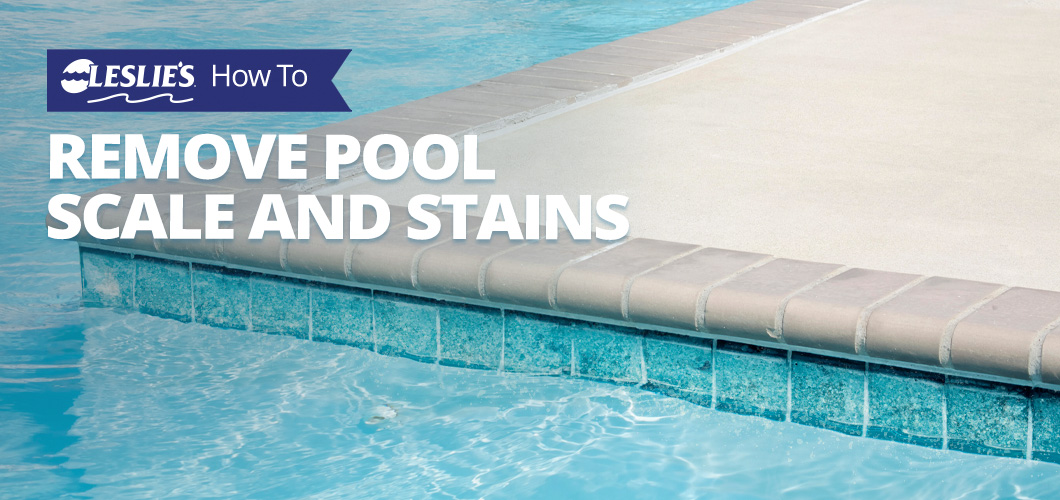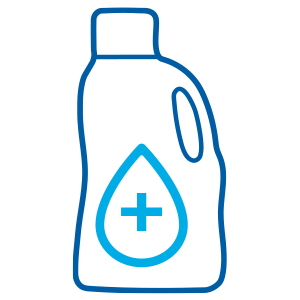
How To Remove Pool Scale and Stains
In the world of pool ownership, stains and scale are two words that often go hand-in-hand because they typically set into your pool at the same time. Pool stain remover and prevention tips to the rescue!
Saturated pool water, choked with calcium and other minerals, can turn your pool water cloudy when typically dissolved solids seep out of the pool water solution due to a chemical imbalance. When this happens, the calcium solids form and bond rapidly with surrounding particles, attaching to your pool surface as an ugly scale stain or as a sheet of dirty calcium film. Just like scale, staining problems most often arise from water balance issues, too. They can also result from organic debris entering the pool.
It might start as just a simple error in pH levels or an innocent shocking of the pool. Next thing you know, the water is cloudy, or scaly pool stains appear days or weeks later. If there are high levels of metals in your water, your pool may be plagued by recurring stains.
For those of you battling waterline pool scale, all-over calcium film stains, or general pool surface discoloration, do not despair. There are solutions to these pesky problems, such as calcium silicate remover for pool surfaces and calcium carbonate removal products. Read on to learn how to deal with swimming pool scaling and staining issues. You can manage most stain and scale issues with the following steps:

Test pool water often to maintain optimal water chemistry. Poor water balance is often the reason stains and scale appear.

Regularly brush all pool surfaces, paying close attention to the waterline. Use a pumice stone or stain/scale eraser as needed.

Prevent scale and stain from returning by using sequestration chemicals to keep calcium and metals "in suspension" in your pool water.
Identifying Types of Pool Scale
Recent blogs on the topic of pool scale problems have popularized the notion of two types of pool scale. In reality, there are at least half a dozen types of calcium scale found in pools. But in the majority of cases of calcium scale and stains, calcium carbonate is the culprit. Nearly every pool is susceptible to cloudy water, stains, and scale deposits when not properly managed.
Calcium Carbonate
This type of scale often deposits a fine sheet of film over the entire pool, but can also produce a stalagmite-like residue that builds up in layers. Calcium carbonate will scrape off easily, and dissolves with muriatic acid or other strong acids. High Calcium Hardness, along with high pH and warm water temperatures, will cause this type of pool scale. It can also come from moisture behind pool tile and raised walls, which leaches out of these surfaces as efflorescence.
Calcium Silicate
As the name suggests, this type of pool scale is calcium mixed with a form of sand. It usually takes a long period of time to create these grayish-white, hard deposits on pool surfaces, which can sometimes abrade skin and snag swimsuits. This alarming result is often the result of high pH combined with high calcium levels. New pool plaster is susceptible to this type of scale during the first year, but you can combat this potential problem by carefully monitoring pH and Total Alkalinity levels during the first summer and winter of a new pool or pool surface.
Identifying Pool Stains
Pool stains not related to scaling issues or an algae bloom are usually caused by one of two things — organic contaminants or metals. Organic stains usually disappear quickly after shocking a pool or with direct applications of granular chlorine and brushing. Metal stains respond best to ascorbic acid (vitamin C) — ascorbic acid is most effective on iron stains, not copper stains. Metal stains come in a rainbow array of colors, so they are usually fairly easy to diagnose.
DIY TIP: If the stain in question can be brushed off, or if it responds to pool shock or direct chlorine applications, there's a chance you may just have an algae bloom. Green algae is the most common, and it likes to cling to pool walls and float near the surface of the water. Mustard algae is yellow in color, and often looks like sand or pollen at the bottom of the pool. Black algae is a little more difficult to manage, and can look like clusters of black spots in the pool. If you're dealing with algae issues, head over to our other blog post: How To Prevent and Remove Algae.
Green or Green/Brown Stains
Leaves, grass clippings, and other organic plant materials in the water often cause these types of stains. Keep up with regular pool cleaning to prevent excess plant debris from settling to the bottom of the pool. Use a pool rake/leaf skimmer, automatic pool cleaner, and/or a leaf vacuum to remove the debris, and thoroughly brush the pool on a routine basis.
Blue-Green Stains
Turquoise and blue-green stains are most often caused by copper in the water. Copper is present in some well water sources, and can also find its way into the water through corroded copper plumbing. A water test can diagnose the cause of these stains. If copper is the problem, your best line of defense is a metal remover or sequestration product, such as Leslie’s NoMetal.
Reddish-Brown Stains
Iron in the pool causes red-brown rust-like stains on pool surfaces. In some cases, these stains may even have a yellow tint to them, or your water may have a slightly yellow hue. Well water is notorious for containing iron. However, it can also be introduced to the pool through nearby iron sources, such as pool fencing, fittings and hardware, rebar near the surface of the pool wall, fertilizers, or tracked in soil with high iron content. A water test will determine if iron is a problem in your pool. You can address iron in your pool water with Leslie’s NoMetal. Keep in mind that oxidized iron stains can turn black, and are very difficult to remove.
Purple Crystals
Purple crystals are an indication of high levels of copper and Cyanuric Acid in the water. These crystals can deposit on the pool surface, tile, and automatic pool cleaners. As above, to address metals in your pool water, use Leslie’s NoMetal.
Other Colors of Stains
Where do stains come from, and what do they look like? Metal stains in the pool can come in a wide array of colors, depending on the type compound formed. Here are some of the more common color variations for pool stains:
| Metal | Source | Possible Colors, Depending on Compounds Formed |
| Aluminum | Erosion or corrosion of fittings, nuts and bolts, trim parts, rail goods | white or yellowish |
| Calcium | Source water, pool plaster, calcium-based sanitizers | white crystals, white or gray-white lumps, white crystalline powder |
| Cobalt | Accelerator used in fiberglass pool and spa shells | red or violet crystals, blue, ruby red, rose red, gray, dark brown |
| Copper | Copper algaecides, copper ionizers, erosion and corrosion of copper pipes, heat sinks, heat exchangers, bronze pump parts and other fittings | blue, dark blue, aqua, black, reddish-brown, brownish-yellow, green, blue-green, purple crystals |
| Iron | Well water, source water, erosion and corrosion of galvanized pipe, heater header, fittings and fasteners | black-brown, brown, dark red, greenish-white, bluish-gray, greenish crystals |
| Magnesium | Source water | white powder, white crystals, clear crystals |
| Manganese | Well water | rose, black, white, pink, green, translucent or pale red |
| Nickel | Erosion or corrosion of nickel from heater headers, plated parts, nuts and bolts | light green, light brown, brown, green, black |
| Titanium | Chlorine generator electrodes, paint pigment | white |
Pool Scale and Stain Removal
If you're only dealing with stains caused by organic contaminants or metals, you'll approach it differently than you would with calcium and mineral stains. Most organic pool stains can be eradicated by simply shocking the pool water. Stubborn stains can be treated with direct applications of granular chlorine and a pool brush. Iron stains can be removed with ascorbic acid powder, such as Leslie's Stain Remover. Keep in mind that ascorbic acid removes chlorine from the water so this product should be used in the off-season.
The best way to remove calcium pool stains and scale from concrete, plaster, and pebble pools may be to drain the pool and acid wash the surface. You could also have the tile line bead blasted. But if you’d rather save time, money and water, keep reading. For manageable amounts of pool calcium deposits, scale, or stains, less drastic (and less expensive) solutions are available. Here are some of the most popular methods of removing calcium or mineral scale and stains in pools:
Pumice Stone
A pumice stone is a natural volcanic stone used on ceramic tile, concrete or plaster surfaces to rub away both main types of pool scale. It’s effective and fun to use (it floats!). However, it wears thin quickly and can make a mess. When using a pumice stone, make sure to keep both the stone and the surface you are cleaning wet at all times to prevent scratching.
Stain Erasers
Stain erasers are made of softer abrasives that are effective on any pool type—even vinyl and fiberglass pools. They’re made for removing calcium scale at the water line or any other place in the pool. True to its name, the stain eraser will rub off stains and scale while you scrub, similar to a pencil eraser. Simply attach to a pool pole or use as a handheld pool stain scrubber.
Descale-It
Descale-It is a safe to use, bio-friendly pool stain removal chemical that works without harsh fumes or rough abrasives. Scrape off the big stuff first, then spray directly on pool scale and efflorescence to remove it. This powerful natural solvent dissolves calcium carbonate scale and helps make removing calcium silicate scale easier when using a pumice stone. It's safe to use with all pool types, and it's also great for spas, sinks, tubs, and showers.
Leslie’s Stain and Scale Remove
Leslie's Stain and Scale Remove is an amazing stain-removing organic polymer that's safe for all surfaces, and works to remove scale and stains caused by calcium carbonate. It’s better than a no-drain acid wash, because this proprietary blend of polymers cleans and protects your pool without the use of acids. It removes built-up mineral film scale, waterline marks, and scale stains in just 2-4 weeks. Keep in mind that this product contains phosphates.
Pool Scale and Stain Prevention
There are specific ways you can prevent scale and stains (or scaly stains) in your own pool. This simple three-step pool stain and scale prevention program will keep your pool in top shape:
- Maintain a clean pool and keep organic waste levels to a minimum. Bio-matter in the pool, including algae, coagulates to form dirty stains, especially during scaling events.
- Regularly test pool water and keep it balanced with proper pH, Total Alkalinity and Calcium Hardness levels. Also check for the presence of metals in the water. Maintain a constant and consistent chlorine level of 2-4 ppm at all times. This becomes more important with water temperatures above 70°F, as warmer water makes it easier for pool water to precipitate calcium scale.
- Add a maintenance dose of high-quality sequestering agent, such as Stain and Scale Prevent, every few weeks to maintain a residual level and keep the calcium and metals “locked in” to the pool water solution. Stain and scale chemicals naturally degrade in sunlight and should be replenished regularly.
Leslie’s Stain and Scale Prevent
Our chemists took our popular Leslie's Stain and Scale Remove, mentioned above, and added a sequestering agent to control minerals and metals. Leslie’s Stain and Scale Prevent keeps stain-causing materials locked in solution with strong molecular bonds. This powerful pool stain and scale solution is a one-step proprietary blend of polymers to remove and prevent pool stains, and it's completely free of phosphates. Just apply once per month to a clean pool with good water balance.
Natural Chemistry Metal Free
Metal Free is a powerful yet all-natural chelating agent that creates strong bonds with metal and mineral ions, keeping them from seeping out of solution. The formula is phosphate free, and effectively manages iron, copper, and other metals. It also prevents scale build-up caused by calcium and trace minerals.
Water Testing
For extra pool scale prevention, analyze your pool water with the Langelier Saturation Index to measure your pool water’s propensity to scale based on five known variables. The math is a bit complicated, but Pentair makes it easy with the Pentair LSI Calculator.
For help with proper water balance or resolving ongoing balance issues, bring a sample to your local Leslie's store for a free 10-point water test. Leslie's AccuBlue® water testing system precisely measures all aspects of your pool's chemistry. It also provides you with a detailed plan of action to resolve existing problems and prevent future staining and scaling issues.
If you are truly committed to a stain-free pool, these tips — and the practical solutions offered by the experts at Leslie’s — will give you the best chance of reducing the conditions where pool scale and stains can occur. A clean, well-balanced pool and quality stain and scale prevention (and removal) products can go a long way in keeping your pool surfaces pristine.
If you have any other questions about removing or preventing stains and scale in your pool, we can help! Stop by your local Leslie's today.